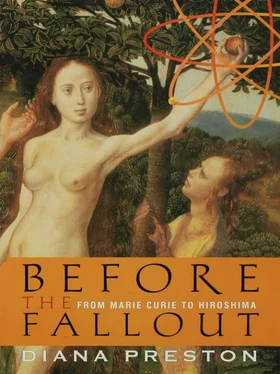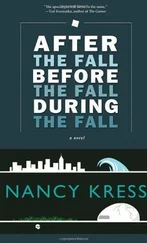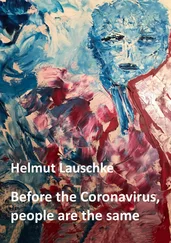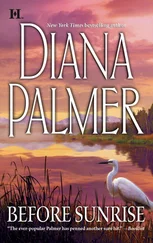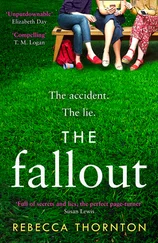Becquerel wrote up his results with both puzzlement and excitement. He had, in fact, discovered radioactivity —the first new property of matter since Isaac Newton identified gravity. Although he did not appreciate the full significance of his findings, he realized that they were important and unexpected, and was therefore piqued when they attracted little comment. Rontgen’s x-rays still commanded all the attention.
• • •
However, Marie Curie read Becquerel’s work and was, as she later wrote, “much excited by this new phenomenon, and I resolved to undertake the special study of it.” Since the subject was “entirely new”—no one except Becquerel had yet written about it—all she needed to do before getting started on her doctorate was to read his papers. Marie was offered a damp little glass-paneled storage room on the ground floor of the School of Physics as her laboratory and on 16 December 1897 began work. Becquerel had noted that his rays released a light electrical charge into the air. Marie therefore decided to measure the electric current emanating from uranium salts. The Curie brothers’ piezoquartz electrometer, sensitive to the faintest trace of electrical current, was tailor-made for her purpose. She found the rays’ activity to be directly proportionate to the quantity of uranium in the specimens and that it was unaffected by light, temperature, or the chemical form the uranium was in.
Wondering whether other chemical elements besides uranium might share these qualities, she plundered her colleagues’ shelves for specimens. Her careful examination of these elements revealed that, in addition to uranium, only thorium, the heaviest of the known elements after uranium, was active. Her measurements also showed that pitchblende, a heavy, black ore rich in compounds of uranium, appeared to be nearly four times as active as pure uranium. This was not what she had expected. She repeated her meticulous tests twenty times, but her results remained the same. Since she had already tested all known elements for activity, logically this could only mean one thing: The pitchblende contained a new element. She told her sister Bronya, “The element is there and I’ve got to find it.”
Marie immersed herself completely in her work, helped by Pierre. As their younger daughter Eve later wrote, he had followed his wife’s progress “with passionate interest. Without directly taking part in Marie’s work, he had frequently helped her by his remarks and advice. In view of the stupefying character of her results, he did not hesitate to abandon his study of crystals for the time being in order to join his efforts to hers in the search for the new substance.”
They began breaking down the pitchblende to extract the tiny fragment containing the activity, hoping thereby to solve the puzzle. They did this by extracting from the pitchblende sulfur of bismuth, a substance which, according to their measurements, was far more active than uranium. Since pure sulfur of bismuth was itself inactive, this meant that the new active ingredient had to be present in the bismuth.
It was laborious, painstaking, but exciting work. As soon as they had extracted a tiny amount of active material, Marie bore it off to Eugene Demarcay, a specialist in spectrography—the science of identifying elements by the rainbow-colored “spectra” they display when energized by an electric current. Although Demarcay had lost an eye in a laboratory accident, his abilities were still acute. He analyzed Marie Curie’s specimen and declared it was something he had never seen before.
The Curies announced their discovery of what they believed to be a new element in July 1898 in the Academy of Sciences’ Comptes Rendus, the most influential scientific publication in France. They declared that, if proved correct, they would name it “polonium” in tribute to the land of Marie’s birth. The title of their paper—“On a New Radioactive Substance Contained in Pitchblende”—coined a new word. The terms radioactive and radioactivity, from the Latin word radius, meaning “ray,” were quickly taken up. So was the term radioelement to define any element with this property.
After a cycling trip to the Auvergne with baby daughter Irene, whose first words—“Gogli, gogli, go”—Marie recorded with as much delight as her experimental findings, they returned to Paris to resume their investigation. As they labored, they were astonished to discover a further new radioactive element in the pitchblende. On 26 December 1 898, just six months after finding polonium, they announced the likely existence of this second new element, naming it “radium” and telling the world that its radioactivity “must be enormous.” Their paper also stated that “one of us” (probably Marie), had shown that “radioactivity seems to be an atomic property”—in other words, it derived from some characteristic within the atom, the tiny brick from which all matter is built.
The Curies had made these startling discoveries with tremendous speed—within a year of Marie beginning her doctoral thesis. They next had to convince the many skeptics that radium and polonium were not fanciful chimera but real. So far they had succeeded in isolating only tiny specimens of each. To prove their existence beyond dispute, they needed larger samples.
It was already clear that radium was the more active of the two and therefore easier to isolate. Accordingly, Marie Curie focused on extracting pure radium—a formidable task since radium constitutes less than a millionth part of pitchblende. She needed fifty tons of water and some six tons of chemicals to process just one ton of pitchblende, from which the maximum yield would be no more than four hundred milligrams of radium—about one hundredth of an ounce. The task required facilities on an industrial scale. Instead, the School of Physics offered the Curies what Marie called a “miserable old shed” abutting the narrow Rue Lhomond. This old wooden hangar with a leaking skylight and a rusting cast-iron stove had been used as a dissecting room. A visiting German chemist likened it to a cross between a stable and a potato cellar.
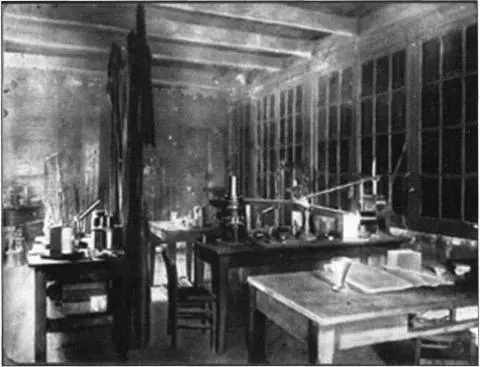
The Curies’ laboratory circa 1898
As Marie Curie recalled, she felt “extremely handicapped by inadequate conditions, by the lack of a proper place to work in, by the lack of money and of personnel.” Nevertheless, the Curies moved in and awaited the delivery of ten tons of pitchblende residue from the St. Joachimsthal uranium mines in Bohemia, the principal source of uranium ore in Europe. The valuable uranium salts extracted from pitchblende were used to dye skins for the then fashionable yellow gloves and to stain glass in rich hues of orange and yellow, but the residue was considered worthless. The Curies hoped it would still contain enough radium for their purposes. When horse-drawn carts finally delivered the sacks of ore, Marie impatiently ripped one open, spilling the contents, still mixed with Bohemian pine needles, out on the courtyard. She tested a chunk with an electrometer and to her relief found it highly radioactive.
Marie effectively took charge. Pierre later admitted that, left to his own devices, he would never have embarked on such an enterprise. Day after day the small figure dressed in a baggy, stained linen smock could be seen obsessively filling cauldrons in the courtyard. She processed the pitchblende in batches, pulverizing, crystallizing, precipitating, and leaching to purify and extract the precious radium, which glowed blue in its glass containers. As she later recalled, “Sometimes I had to spend a whole day mixing a boiling mass with a heavy iron rod nearly as large as myself. I would be broken with fatigue at the day’s end. Other days, on the contrary, the work would be a most minute and delicate fractional crystallization, in the effort to concentrate the radium.”
Читать дальше
